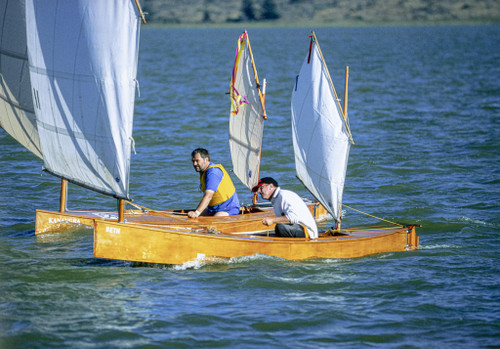If you prefer printed plans, click HERE
This article details how one owner has used the same drop in rig on several different canoes over the last 13 years.
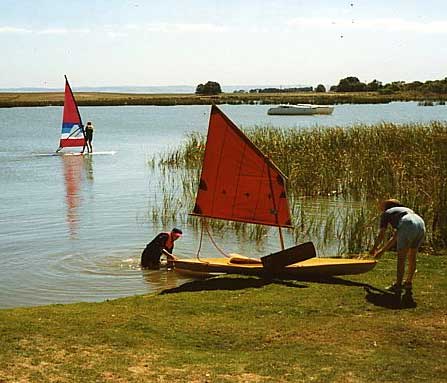
Sailing Rigs for Canoes and kayaks usually break into three groups.
There are auxilary sails for (usually) seakayaks that are used to propel the boat downwind only.
There are rigs to give a canoe high performance.
A rarely seen variant is something in between - a no-fuss rig that does not make the boat hard to handle but provides enough power to sail reliably upwind and down. It should include a sensibly sized leeboard so windward progress is reasonably efficient. It is important that the leeboard is of a reasonable size - boards much smaller than this have poor windward performance.
This rig is the third type. It does not offer the highest performance possible, but it is small enough to fit inside the boat when not in use. The leeboard necessary for upwind sailing is removed at the same time as the mast support leaving the boat ready to be used as a pure paddling canoe.
Recently I received an email from Trevor Killmier who purchased the first set of the plans 10 or more years ago. I'll let him tell the story:
Hello Michael,
You may remember me from way back. I think we last corresponded back in 95/96. You designed a drop in sail rig for a fibreglass canoe we had.
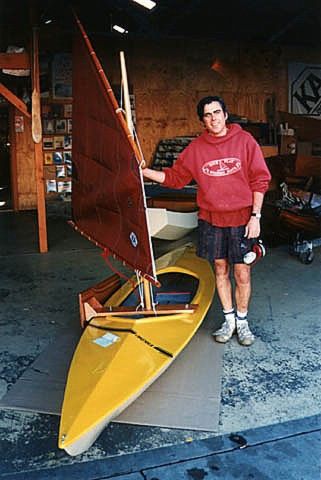
I was delighted to see a photo of it on the Duck Flats website and I'm pleased that you're marketing the rig again because I get many inquiries about it.
We had a lot of fun out of that sailing canoe (picture above - the rig was built by David Wilson of Duck Flat) but I think in retrospect the hull was quite unsuitable for sailing. It had a very strong weathercocking tendency and I think I wrote and told you that I managed to hurt myself sailing it.
I eventually added a rudder and was able to sail it myself again. My son also taught himself to sail in it and had an enormous amount of fun. However, it was impossible to right after a capsize unless you were able to stand up and so I looked for a more suitable hull. I had the plans of John Bull's Peterboat sailing canoe and had started building one of those before I hurt myself. Some years later, I was able to resume that construction and completed it, launching it in 98.
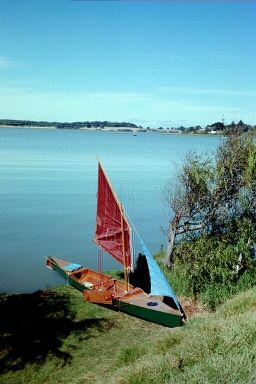
The plans call for a 40 ft² lateen rig but I sail down at Clayton mostly and always thought that was just too big. So, I simply transferred your rig across to the new boat and it has proved perfectly satisfactory. I have since added a small tie on jib and an outrigger and have been sailing regularly since 98. (picture above is launching day)
I am now building John Bull's little Pete -- a single seat version of the same canoe -- and will transfer the rig over to that.
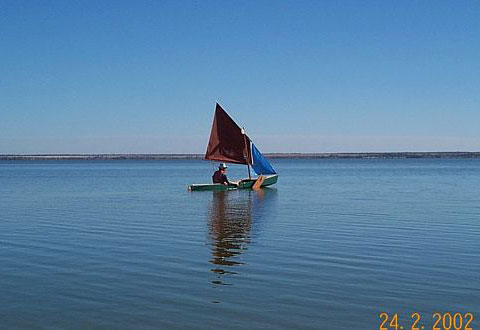
I regret not being in touch with you earlier simply to convey how much pleasure I get out of this boat. I guess I'm a minimalist at heart but I'm sure there are many people out there with much bigger boats, far heavier and more expensive, who just don't get the amount of fun out of their boats that I do out of mine. The only drawback is that I sometimes don't get to sail it because I spend so much time talking to interested onlookers! (picture above - canoe at Barmera)
Rosemary and I have a van in the caravan park at Clayton and another semipermanent occupant of the park has told me that he wants to build one. I haven't seen him for a while but have told him that the rig is yours. Now I'll be able to direct him to the site.
I have some photographs of the rig on the Peterboat and if you would like to see them or even use them for marketing purposes, I would be happy to send them to you.
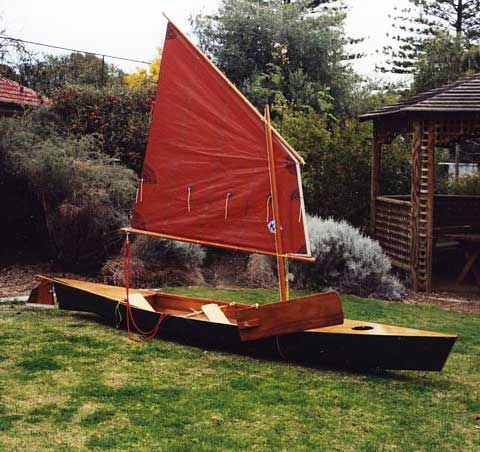
Regards,
Trevor Killmier.
Wow - how lovely to hear from you Trevor!!!
Your letter is EASILY one of the nicest things I have read in a while. When I design something it is often the case that I send the plans off, have a bit of correspondence while the boat is being built etc.
BUT ... to get a letter after 10 years showing the damn thing works, that it has been moved from boat to boat - AND MOST IMPORTANTLY - has fitted into someones lifestyle so perfectly is just the best thing.
Thank you so much!
If there are photos available of the different incarnations of the rig I would love to see them - perhaps to scan them and put on my website.
Again thank you for getting in contact!
Best Regards
Michael
Thanks Michael,
Yes, the damn thing really works!!!!! And works so well for me. I'll hunt out some photos, scan them and forward them to you. I know there are photos of the rig on both the yellow canoe and the Peterboat so I'll look for a selection.
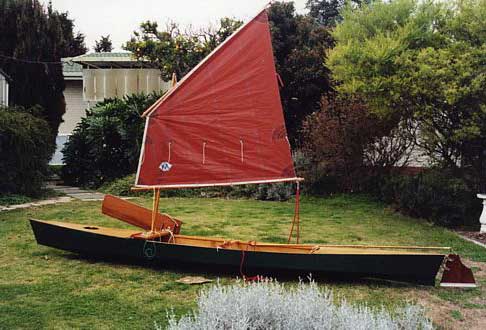
I'm glad you're still interested in this idea - I just can't understand why more people don't add a rig to their canoes. Instant sailing boat: instant fun. Have you tried it on the Eureka design?
Regards,
Trevor.
Note: I think the boat in the photo has the sail hoisted a little bit too high (compare the photos from Trevor Killmier to the drawings). Keeping it a bit lower will reduce the heeling force (less chance of capsizing) and also reduce the load on the mast. Moving the halyard a little further back on the yard (the wood along the top edge of the sail) will cock the boom up so it won't hit the user's head. That's the designer's (my!) opinion, but Trevor has 10 years of experience of the rig with a series of different boats in a range of different conditions - so who am I to argue! :-) I would suggest setting the rig up like the drawings to start with, but if there are problems with head clearance, move towards Trevor's setup.
Notes from the Plan:
This rig is designed to drop into a paddling boat, whether canoe or kayak. As far as possible all the gear is removable from the boat except for the mast step and three unobtrusive fittings that will not interfere with the paddling function. The blue jibsail in some of the photos is not part of the plans.
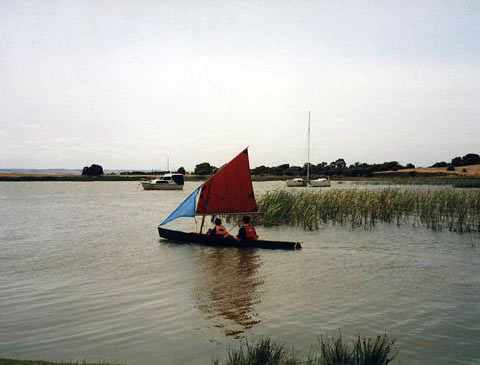
Many people have a paddling boat and would like to gain a feel for sailing at moderate additional cost. The objective of this rig is to add the ability to sail to the function of an existing boat without interfering with its existing paddling performance.
If steering with a paddle take particular note of the section at the end on sailing the kayak. It explains how to adjust the leeboard to minimise the steering loads.
A reefing point has been specified in the drawings to enable the sail area to be reduced in marginal conditions. It is not expected that the boat will be able to sail upwind while reefed, though it will still be able to sail well downwind.
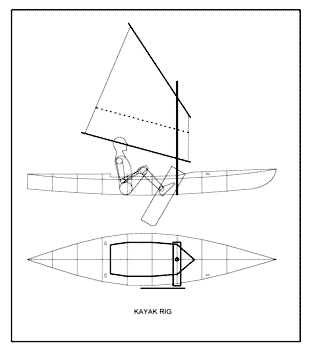
I would recommend doing some practice capsizes in safe waters on a warm day to see if you can rescue yourself or if you need outside assistance.
The spars and leeboard have been sized to fit inside most boats or the leeboard can be swung forward to be out of the way of the paddler should the boat have to be paddled home.
MAKE SURE THE BOAT IS EQUIPPED WITH AND THAT YOU WEAR APPROPRIATE SAFETY EQUIPMENT. KEEP AN EYE ON THE WEATHER.
Another factor for consideration is that canoes and kayaks can be very fast under sail - particularly with the wind coming from astern. Take care not to go excessive distances from your home base without realising and setting yourself up for a very long paddle home. A good way to avoid such problems is to start toward the direction the wind is coming from - then you will be able to enjoy a quick sail home.
Feedback:
Yee Haa! What a hoot! Winds yesterday afternoon were Force 3 to 5 with plenty of gusts to Force 6 or more. Sunny and temperatures dropping through the forties. Lake water cooled by snow melt. The canoe sailed more predictably than under lighter conditions. I'm ready to replace temporary c-clamps (g-cramps to you) with screws and cleats.
I am highly pleased with the performance of Michael Storer's drop-in canoe sailing rig. The little balanced lugsail, all the spars, the leeboard and the integral mast partner and leeboard brace are from his drop-in canoe sailing rig. The only thing I changed is that I made it so that the pivot point is below the gunwale instead of above it (*) and I extended the foil stiffener above the top of the leeboard to provide a handle. I added an articulated extender (stick & bolt) to that and am using nut tightness to hold it in position...will probably harden that up with a line & cleat in future. In these windy conditons she seemed to sail best with the board down about 15-20 degrees off vertical. The rigging is all MIK's. The only modification I made to the hull (16 ft ABS Esquif Presage canoe) was to glue in a mast step. I used small rope loops tied to thwarts instead of the hardware specified. I may eventually stiffen those up a bit but the lines ran smoothly today.
I love how easily I can set up and take down this rig. I just throw the bundled up sail and spars and the leeboard into the back of the van. It is not even necessary to remove the clamp-on brace as it clears my roof rack with ease.
This was my fifth or sixth outing with this rig and the windiest by far. I have tweaked things each time and am now pretty satisfied with it. I only needed to paddle steer a little since I have now got the overall balance about right. I did not need to do much leeboard adjustment today, either...just raised it a bit while running and back down on close reach. My weight forward to initiate a change of tack, back once throught he eye of the wind.
When I first got the plans I was a bit troubled that the sail was so small (17 sq ft). Someday I may make a bigger rig, but this rig makes sailing in strong gusty winds feel safe, and with eight foot spar lengths it is easily stowed in the canoe. Still exhilarating but not scary. For me that is perfect for winter. The flex of the spars is such that the gusts depower the sail just enough; and then she scoots as the gust blasts on across the lake, the spars straighten and the full draft returns to the sail. I'll get some more photos one of these days but there was nobody at the lake today to handle a camera. I had my drysuit on but never felt anywhere near needing it.
The surface of Lake Arrowhead, near Luray, VA, does not get much chop because it is protected from the wind by the surrounding hills. Its small size (40 acres) also keeps large waves from building. The lake lies in the lee of a couple of small mountains which cause the wind mix and swirl when steady stiff breezes can be observed out on the open valley floor. Still, it was a great workout. I was on the water a bit less than an hour and a half. Quit when the sun was five degrees from the horizon. The lake is thirty minutes from home, so I didn't blow off the whole day.
(*) Now to the point for PDR builders: This morning I was getting ready to repair some nicks on the bottom of the leading edge of the leebard when I noticed that the leeboard bracket had broken and was only being held by three screws. MIK's design called for the bracket to be made with the pivot above the gunwale and I wanted it lower. My change caused me to leave out two gussets and that lack of support is why it failed. MIK does not over engineer. If you see a brace in one of his designs it would be best not to omit it. It is very likely there for good reason.
--
Paul Helbert
Father of "The Canoe Guru" http://thecanoeguru.com/
Materials list for Drop-in Rig (PDF file)
Sail Area 17.6 sq ft or 21.6 sf
Mast, Yard and Boom length for both sails - 1.65m (5ft 5 ins)






